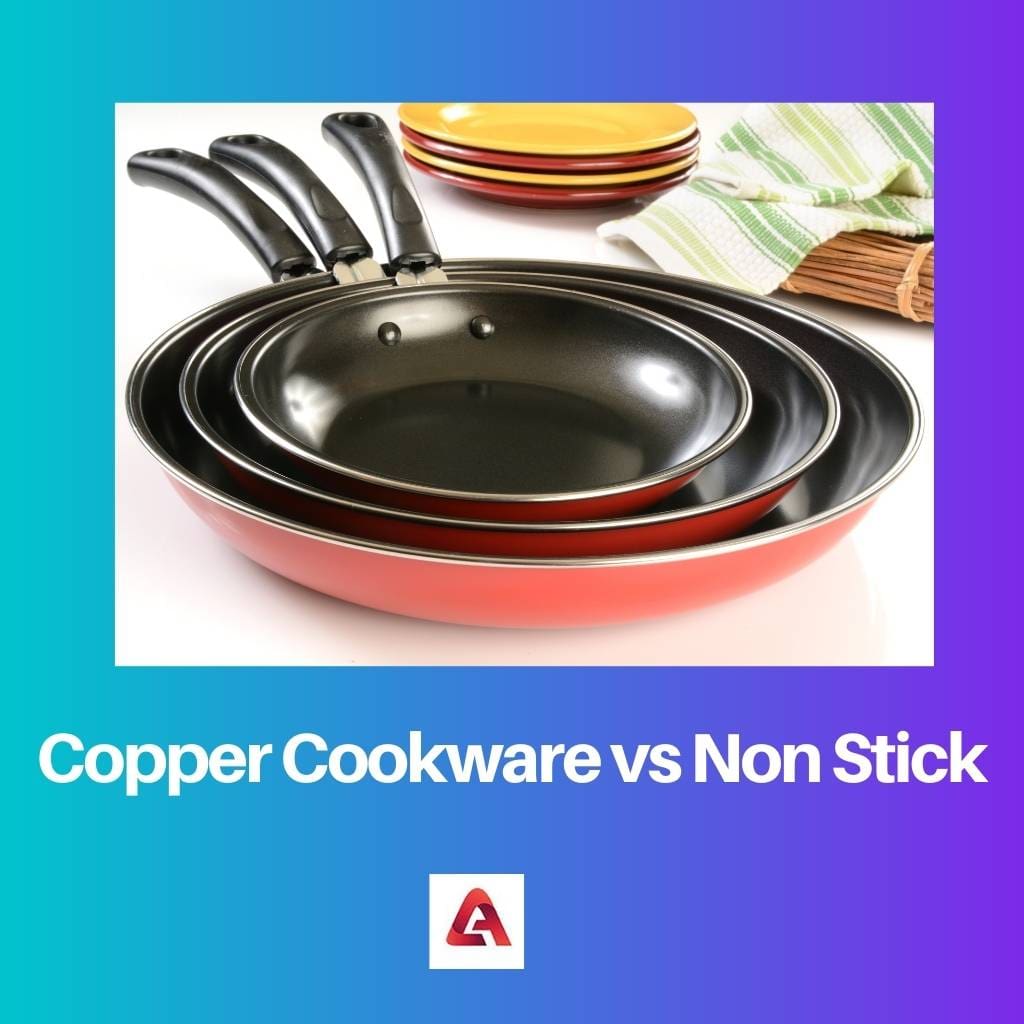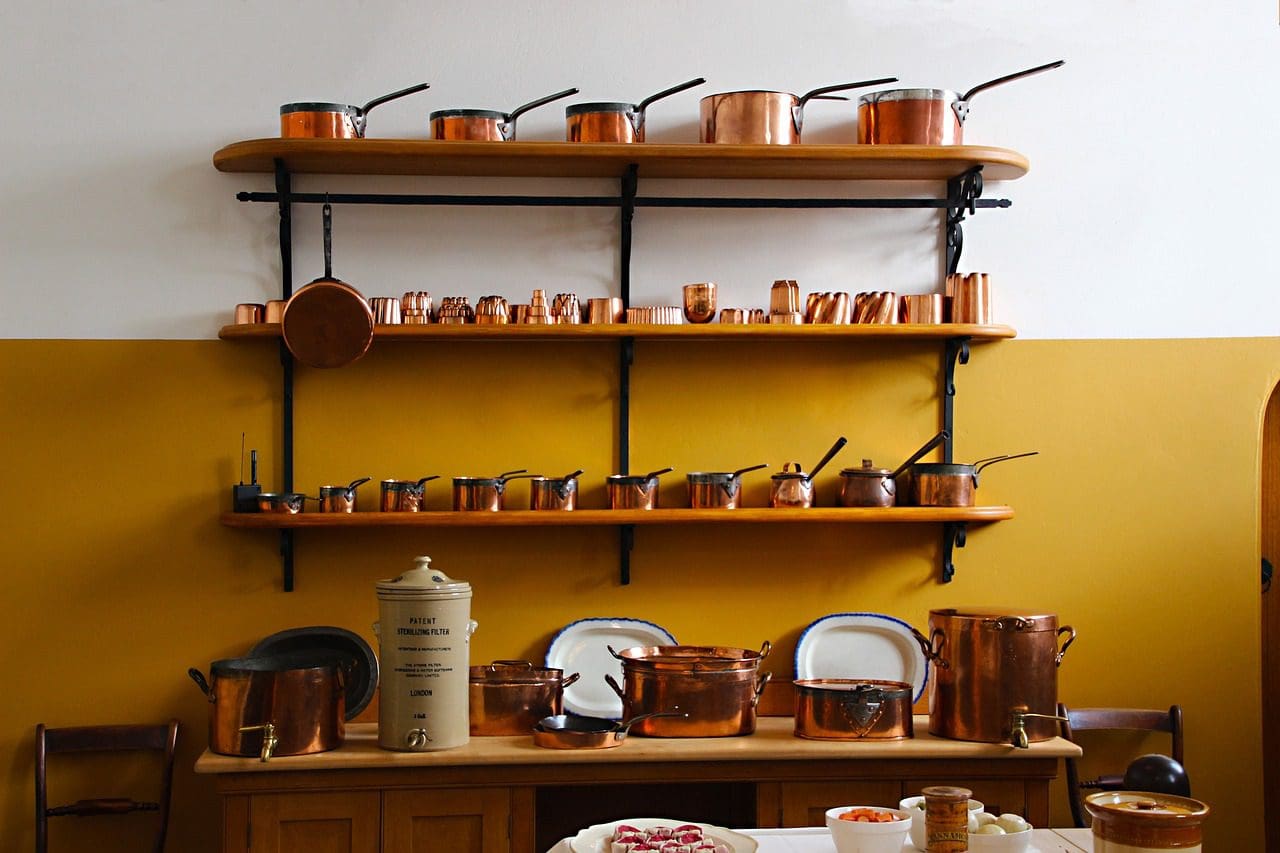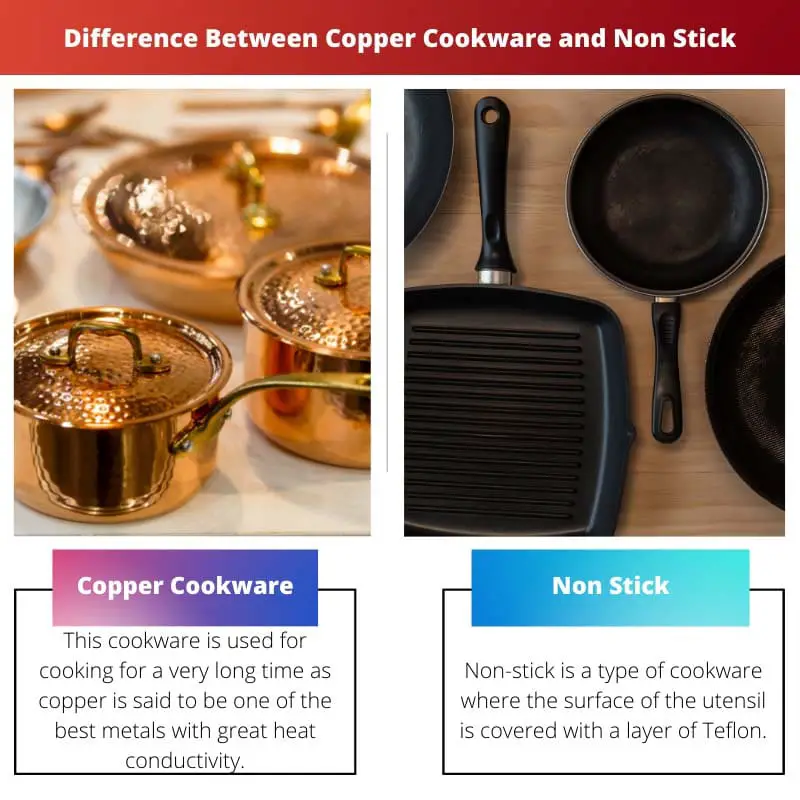Cooking is an activity that takes place everywhere, irrespective of the country, economic condition, or culture. It has been done from the start of time. While earlier, it was easy as mostly half-cooked or raw vegetables were eaten.
But nowadays, several dishes and soups and various things have been introduced. Barely anyone eat half or uncooked vegetable (unless it is a salad). Certain new pieces of equipment have been introduced with some advanced technology to cook them.
That makes it easy to complete the process, causing problems such as burning or even overcooking. These types of equipment include Copper cookware and Non-Stick. In contrast, both of them serve the same purpose of cooking but are very different from each other.
Key Takeaways
- Copper cookware is a type of cookware made of copper, which conducts heat well and is used by professional chefs, whereas non-stick cookware has a special coating that prevents food from sticking to the surface.
- Copper cookware requires more maintenance, as it needs to be cleaned and polished regularly to prevent tarnishing, while non-stick cookware is easier to clean.
- Copper cookware is more expensive than non-stick cookware but is also more durable and has a longer lifespan.
Copper Cookware vs Non-Stick
The difference between Copper Cookware and Non-Stick is that Cooper Cookware, due to the presence of copper, is good at heating up fast and also spreading the heat evenly, while in comparison, non-stick cookware does not heat quickly (unless they also have a coating of copper). They also differ in terms of affordability, reactivity, etc.

Copper Cookware is cooking utensils made up of copper. Therefore, it has all the properties of the metal. It is considered good for fast cooking due to its high conductivity power of heat.
They are used for a while and are oven friendly too. They come with some disadvantages too, such as they need maintenance and cannot be used with any food with acidic nature.
Non-Stick is a type of cooking utensil specially designed so that food while cooking should not stick to the surface or get burnt. It takes more time than copper cookware to prepare food with these utensils. But it is highly affordable and does not require much maintenance.
Comparison Table
| Parameters of Comparison | Copper Cookware | Non Stick |
|---|---|---|
| Made up of | Cooper | Coated with a material called polytetrafluoroethylene or Teflon. |
| Reactive | It is highly reactive to acidic food. | Non-reactive |
| Heat conductor | Better heat conductor | Comparatively not a good conductor |
| Affordability | Costly | Pocket friendly |
| Maintenance | Requires polishing | Does not require high maintenance. |
What is Copper Cookware?
This cookware has been used for cooking for a very long time as copper is said to be one of the best metals with great heat conductivity. It has benefits such as Conductivity, the foremost benefit any copper cookware has is excellent thermal conduction, the utensil gets heated up and cool down fast, therefore in time of hurry or urgency, it is a great option, it also spreads heat evenly, and therefore, there is less or no chance of food getting burnt.
And another benefit could be its beautiful and shiny appearance. Along with all the advantages it has, there are some disadvantages too, such as it cannot be used to cook that is not based in nature or is acidic this is because copper reacts with acid.
Also, copper cannot be used if you are cooking using an induction cooktop. Last but not least, it is expensive, and for some people, it might not be worth each penny.
Therefore, copper cookware can be used easily by an experienced person who knows how to handle it; otherwise, it will be quite difficult for any person who is new to cooking. And to terminate the disadvantages, copper cookware comes with a layer of some other metal to prevent burning or any acidic reaction.

What is Non-Stick?
Non-stick is a type of cookware where the surface of the utensil is covered with a layer of Teflon to avoid or restrict the food from getting stick to it.
Advantages of Non-stick cookware include:
- It is much more affordable than any other cookware available in the market.
- There is no or very minimum chance of food getting stuck in the utensils.
- Due to the non-stick surface, it is easier to cook with it.
- It is the best option for someone with less or no experience in cooking.
- As food does not get burned in it, it is very easy to be cleaned. No extra effort is required.
- There are no health risks involved if food is cooked with it.
Disadvantages
- It should be washed with a soft pad or scrub; otherwise, the surface could be damaged.
- There is a risk of the coating getting melted at a higher temperature. Therefore it is not recommended to use them at such a temperature.
- It cannot be used for the oven.
With all the disadvantages and advantages, it is clear that it is best for someone who is trying their hands-on cooking for the first time, but for someone with experience, other cookware would be great.

Main Differences Between Copper Cookware and Non-Stick
- Copper Cookware has been used mostly due to its advantage of being a good heat conductor as it is made up of copper. It cooks food faster than most of the other utensils making it preferable at the time of urgency, while non-stick cookware, when compared to it, is not a good conductor of heat as copper.
- Another main difference could be that nowadays, people are using Induction cooktops for daily cooking as well, but with copper cookware, it is not possible as they cannot be used for induction cooktops, while non-stick has an advantage here as they can be used with induction cooktops.
- Copper cookware, despite its advantage, is not used by many; the reason is that it is very costly, that not everyone can afford them, whereas non-stick is much more affordable in comparison.
- Food that has acidic content or is acidic cannot be cooked with copper cookware as copper is highly reactive to the acidic substance, while non-stick is not acidic reactive cookware.
- For the long term also, non-stick is the best option as no extra maintenance is required to keep it shiny and long-lasting, while in the case of copper cookware, polishing and other maintenance are required to keep cookware shiny and attractive.

- https://link.springer.com/article/10.1007/s11356-020-09970-z
- https://www.sciencedirect.com/science/article/pii/S0261306913007073





I appreciate the detailed coverage of the properties and uses of both copper and non-stick cookware. It’s very informative for anyone looking to invest in quality kitchen tools.
I found the explanation of the differences in reactivity between copper and non-stick cookware to be very enlightening. It’s essential knowledge for anyone dealing with acidic foods in their cooking.
I agree, Graham. Being aware of the reactivity of different cookware materials can help prevent unwanted chemical reactions with certain foods.
Absolutely. Understanding the properties of cookware materials is crucial for maintaining food quality and safety during the cooking process.
The comparison table provided in the article is very informative. It clearly outlines the differences between copper and non-stick cookware.
I agree, the article effectively highlights the key aspects of both types of cookware, making it easier to make an informed decision.
The affordability of non-stick cookware is definitely a big advantage. It makes cooking more accessible to many people.
I always prefer using copper cookware for my cooking due to its excellent heat conductivity and even heat distribution. It provides a professional touch to my cooking.
I find that the maintenance of copper cookware can be a bit of a hassle, but it’s definitely worth it for the cooking results it provides.
I totally agree with you, Mark. Copper cookware is a game-changer in the kitchen.
The advantages and disadvantages of both copper and non-stick cookware are well-explained in this article. It provides a comprehensive understanding of both options.
I appreciate the detailed explanation of the pros and cons of each type of cookware. It’s very useful for someone who’s considering investing in new kitchen equipment.
I found the section on the advantages of non-stick cookware to be quite insightful. The low chance of food getting stuck makes it very convenient for everyday cooking.
Absolutely. Non-stick cookware can simplify the cooking process, especially for those with limited cooking experience.
I agree, Abbie. The ease of cleaning non-stick cookware is definitely a key advantage that shouldn’t be overlooked.
The article presents a balanced view of the benefits and limitations of both types of cookware, allowing readers to make more informed decisions based on their specific needs.
Well said, Peter. The article’s comprehensive approach is very helpful for understanding the considerations when choosing cookware.
The article provides a good overview of the benefits of non-stick cookware, especially for those who are new to cooking or want an easier cleaning process.
The benefits of copper cookware are clear, but the cost can be a barrier for some. Non-stick cookware seems to offer a more affordable alternative with its own advantages.
I also appreciate the article’s attention to the differences in heat conduction between the two types of cookware. It’s an important factor to consider for cooking performance.
Absolutely, the cost factor is definitely something to consider when choosing between copper and non-stick cookware.
The discussion of the heat conductivity of copper cookware is very informative. It helps to understand why it’s favored by professional chefs.